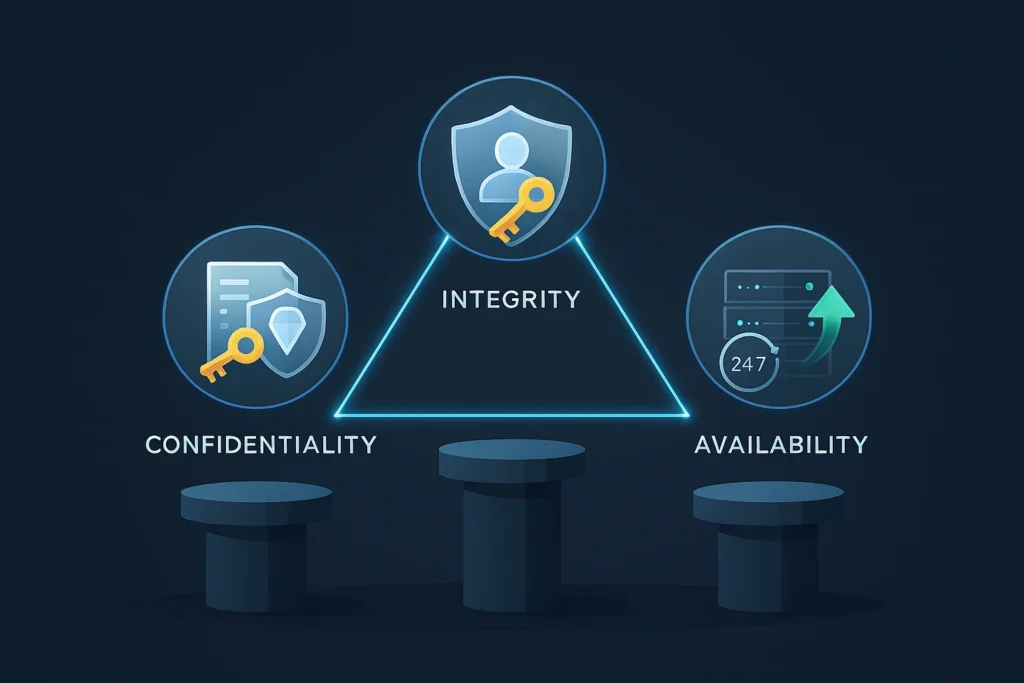In today’s landscape, cybersecurity isn’t just about tools—it’s about principles. The CIA Triad forms the cornerstone of information security, guiding how organizations protect sensitive data and maintain operational continuity. For most organizations, achieving a balance between confidentiality, integrity, and availability is challenging but essential. A single misstep can lead to compliance gaps, financial loss, or reputational damage.
This guide walks you through practical steps to implement and balance the three principles effectively. You’ll see how layered defenses, access controls, and redundancy strategies work together to reduce risk and build trust.

Understanding the CIA Triad
The CIA Triad consists of three core principles:
- Confidentiality: Ensuring that data is accessible only to authorized users.
- Integrity: Maintaining the accuracy and consistency of data over its lifecycle.
- Availability: Guaranteeing that systems and data are accessible when needed.
These principles often compete. For example, strict confidentiality controls might hinder availability. Therefore, balancing them requires a nuanced approach tailored to your organization’s risk exposure.
Confidentiality: Protecting Sensitive Data
Confidentiality prevents unauthorized access to data. In practice, this means implementing controls like encryption, access policies, and user training.
Consider phishing campaigns: they often target employee credentials to bypass technical safeguards. According to the 2023 Verizon Data Breach Investigations Report, over 80% of breaches involve stolen or weak credentials. You can reduce this risk by enforcing multi-factor authentication (MFA) and role-based access controls.
Encryption also plays a key role. Tools like AES-256 protect data at rest and in transit, ensuring that even if data is intercepted, it remains unreadable.
Integrity: Ensuring Data Accuracy
Integrity ensures that data remains unaltered and trustworthy. Unauthorized changes—whether from malware, human error, or malicious insiders—can disrupt operations and decision-making.
Ransomware attacks, for instance, directly threaten integrity by encrypting files and demanding payment for restoration. The average cost of a ransomware incident now exceeds $4.5 million, according to IBM’s 2023 Cost of a Data Breach Report.
To safeguard integrity, use techniques like:
- Cryptographic hashing to verify data authenticity.
- Version control and audit trails to track changes.
- Regular integrity checks using tools like Tripwire or OSSEC.
Aligning with frameworks such as MITRE ATT&CK helps you detect and respond to integrity threats faster.
Availability: Maintaining System Resilience
Availability ensures that systems and data are accessible when users need them. Downtime—whether from DDoS attacks, hardware failure, or misconfiguration—can result in significant revenue loss and erode customer trust.
For example, a 2024 study by Gartner found that downtime costs organizations an average of $5,600 per minute. To enhance availability, implement:
- Redundant infrastructure and failover systems.
- Regular backups stored offsite or in the cloud.
- DDoS mitigation services and traffic filtering.
Balancing availability with other principles often means designing systems that are both secure and resilient. Therefore, conduct regular disaster recovery drills and update incident response plans.
Balancing the Triad: A Pragmatic Approach
Balancing confidentiality, integrity, and availability requires trade-offs. A healthcare provider, for instance, must prioritize confidentiality for patient records but also ensure availability for emergency access.
Follow these steps to achieve balance:
- Conduct a risk assessment: Identify which assets require higher confidentiality, integrity, or availability.
- Implement layered defenses: Use firewalls, intrusion detection systems, and encryption together.
- Monitor and adapt: Continuously review access logs, threat intelligence feeds, and system performance.
In practice, frameworks like NIST CSF (Cybersecurity Framework) provide structured guidance for maintaining this balance while meeting compliance requirements such as HIPAA or GDPR.
Conclusion: Strengthening Your Security Posture
The CIA Triad isn’t a one-time project—it’s an ongoing commitment. By aligning your defenses with these principles, you reduce both compliance risk and potential breach costs. Remember: effective cybersecurity combines technology, processes, and people.
Start today by assessing your current implementation of confidentiality, integrity, and availability controls. This way, you build a safer architecture that supports business goals and maintains trust.
FAQ – CIA Triad
What is the most challenging aspect of the CIA Triad to maintain?
Availability often poses the biggest challenge because it requires continuous uptime and resilience against attacks like DDoS, while still respecting confidentiality and integrity controls.
How does the CIA Triad relate to compliance?
Regulations like GDPR and HIPAA are built around the CIA Triad. For example, GDPR emphasizes confidentiality (data protection) and integrity (accuracy), while HIPAA requires availability (timely access to health records).
Can you prioritize one principle over the others?
Yes, depending on your industry. Financial institutions may emphasize confidentiality and integrity, while e-commerce platforms focus heavily on availability. Always base priorities on a risk assessment.
What tools help implement the CIA Triad?
Encryption tools (for confidentiality), hashing and digital signatures (for integrity), and redundancy solutions (for availability) are essential. Solutions like HashiCorp Vault or AWS Key Management Service can help.
How often should we review our CIA Triad alignment?
Review at least annually or after significant system changes. Regular audits and penetration testing ensure controls remain effective against evolving threats.
No post found!


